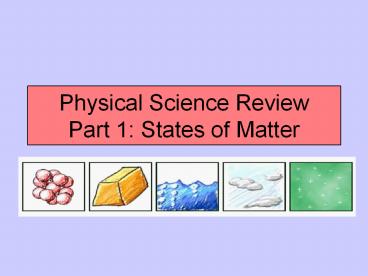Physical Science Review Part 1: States of Matter - PowerPoint PPT Presentation
1 / 15
Title:
Physical Science Review Part 1: States of Matter
Description:
Physical Science Review Part 1: States of Matter Matter: It s what the world s made of. STATES OF MATTER SOLIDS So what is a solid? Solids are usually hard ... – PowerPoint PPT presentation
Number of Views:82
Avg rating:3.0/5.0
Title: Physical Science Review Part 1: States of Matter
1
Physical Science Review Part 1 States of Matter
2
Matter
- Its what the worlds made of.
3
STATES OF MATTERSOLIDS
- Particles of solids are tightly packed, vibrating
about a fixed position. - Solids have a definite shape and a definite
volume.
4
- So what is a solid? Solids are usually hard
because their molecules have been packed
together. The closer your molecules are, the
harder you are. - Even when you grind up a solid into a powder, you
will see little tiny pieces of that solid under a
microscope. Liquids will move and fill up any
container. Solids like their shape.
5
STATES OF MATTERLIQUID
- Particles of liquids are tightly packed, but are
far enough apart to slide over one another. - Liquids have an indefinite shape and a definite
volume.
6
- So what is the big deal about liquids? Solids are
hard things you can hold. Gases are floating
around you and in bubbles. What is a liquid?
Water is a liquid. Your blood is a liquid.
Liquids are an in-between state of matter. They
can be found in between the solid and gas states.
- Liquids have three main properties
- It does not have a definite shape.
- It has a definite mass.
- It has a definite volume.
7
STATES OF MATTERGAS
- Particles of gases are very far apart and move
freely. - Gases have an indefinite shape and an indefinite
volume.
8
- Gases don't keep their shape, and don't keep
their volume either. If you had one liter of a
gas, such as nitrogen, and you pumped it into a
2-liter jar, the gas would swell to fill up the
whole 2 liters.
9
State Changes
- Solids can melt and become liquids, and liquids
can boil to become gases. Likewise, gases can
condense to become liquids, and liquids can
freeze to become solids. Sometimes solids can
even become gases without ever becoming liquids.
But what makes solids melt, and what makes gases
condense?
10
HEAT!
- The simple answer is heat. But what is heat? Most
of you probably have felt hot or cold. But what
makes something hot or cold? Heat is a form of
energy. Heat is the energy of moving molecules. - Click on the following link to show how the
molecules move when heat is added. - http//www.miamisci.org/af/sln/phases/copperliquid
.html
11
Changing States of Matter
- Let's think about an ice cube. An ice cube is a
solid, that is, its molecules aren't moving
relative to each other. They may be shaking and
vibrating, but they stay put. If we heat the ice
cube, its molecules start moving around more. If
we heat the ice cube enough, the molecules will
start moving around relative to each other, and
when this happens, the solid ice melts and
becomes liquid water. If we keep heating the
liquid water, eventually the water molecules will
be moving so fast that they won't want to stay
with each other anymore. When this happens, the
liquid water becomes a gas. Now you have water
vapor! - Click on the following link for animation of
States of Matter - http//www.media.pearson.com.au/schools/cw/au_sch_
whalley_sf1_1/int/2_slg.html
12
Changing States of Matter
- All this can happen backwards, too. If the water
vapor gets cold enough, it will condense back
into liquid water, and if we keep cooling the
water, it will freeze to become ice again. - Click on the following link for molecule
animation of states of matter - http//www.media.pearson.com.au/schools/cw/au_sch_
whalley_sf1_1/int/matter.html
13
States of Matter Foldable
- Now draw the following table on the inside of
your foldable
Description of Phase Change Term for Phase Change Heat Movement During Phase Change
Solid to liquid Melting Heat goes into the solid as it melts.
Liquid to solid Freezing Heat leaves the liquid as it freezes.
Liquid to gas Vaporization, which includes boiling and evaporation Heat goes into the liquid as it vaporizes.
Gas to liquid Condensation Heat leaves the gas as it condenses.
14
States of Matter Foldable
Fold lines
INSIDE PANEL Draw table here. It may take up all
3 panels if necessary.
15
States of Matter Foldable
Fold Lines
Outside Panels Use these 2 panels to describe in
detail with pictures the 3 states of matter.
Cover Page
Name

